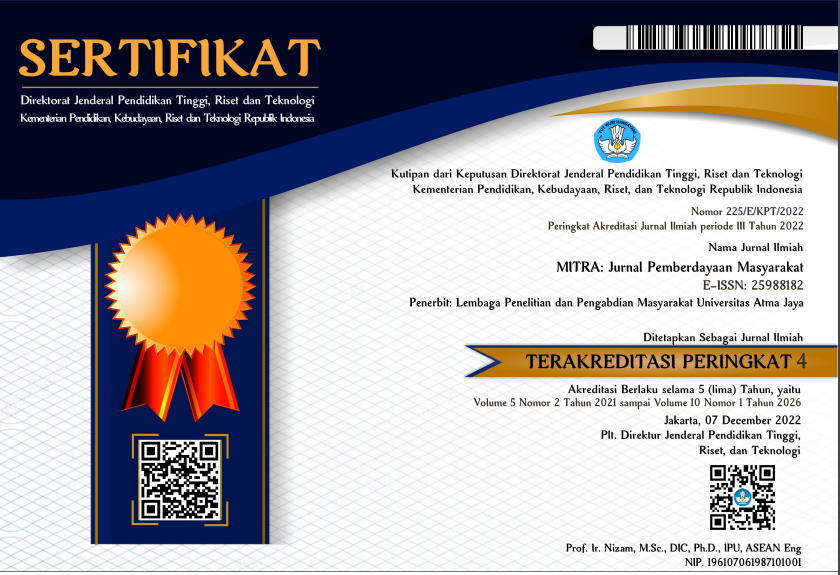Education on Recognizing of Rice Bug Pest (Leptocorisa acuta F.) and its Control on Rice Plant in Palakahembi Village, East Sumba Regency
DOI:
https://doi.org/10.25170/mitra.v4i2.1297Keywords:
rice bug pest, fitfall trap, biopesticideAbstract
The Palakahembi Village is one of the villages whose main commodity is rice plants. The present community-service activities were implemented in Palakahembi Village, East Sumba Regency, East Nusa Tenggara Province. This activity targeted the farmer groups of Ndula Kita and Marangga Panamung. It aimed to provide the farmers with knowledge about pest control and how to control the rice bugs with biopesticide and fitfall trap. The activities we carried out included workshops and mentoring practices for making fitfall trap, making biopesticide, and application of biopesticide on rice in the field. The farmers were provided with knowledge about pest control by making them conduct a direct survey of rice plants that were attacked in the field, followed by the practice of making fitfall trap and making biopesticide and their application to rice plants. The results showed that the farmers were able to understand the morphology and the symptoms of the rice bug attack, as well as the techniques of making the biopesticide along with the application of the biopesticide in the rice plant. Besides, the application of biopesticide at a concentration of 1/5 L (1 litre of biopesticide/5 litres of water) in rice plants also resulted in lower attack rates as much as 80% and higher productivity (6,2 tons/ha) compared to the control group.
References
Balai Besar Pertanian Tanaman Padi. (2009). Hama walang sangit (Leptocorisa acuta). Diakses dari http://bbpadi.litbangdeptan.go.id., 23 Januari 2020.
Fatmawaty, A. P., Dusep, S., & Samsidik. (2013). Pengaruh kombinasi jenis dan dosis pestisida nabati terhadap walang sangit (Leptocorisa oratorius) pada pertanaman padi (Oryza sativa L.). Jurnal Agroekoteknologi. 5(1), 54-62.
Jayanti, S., Elfrida, & Dede, L. (2017). Pengaruh akar tuba (Derris eliptica) sebagai pestisida organik pembasmi keong sawah (Ampullaria ampullaceae) di Desa Tenggulun Kecamatan Tenggulun Kabupaten Aceh Tamiang. Jurnal Jeumpa, 4 (2),21-29.
Laba, I. W. (2010). Analisis empiris penggunaan insektisida menuju pertanian berkelanjutan. Orasi profesor riset di Bogor. Pengembangan Inovasi Pertanian, 3,120-137.
Ramli & Nina, S. (2013). Efektifitas aplikasi pestisida nabati terhadap hama walang sangit pada tanaman padi di Kelompok Tani Mandiri Desa Cipeyeum Kecamatan Haur Wangi Kabupaten Cianjur. Jurnal Agrosains, 6, 42-51.
Siregar, A. S., Darma, B., & Fatimah, Z. (2014). Keanekaragaman jenis serangga di berbagai tipe lahan sawah. Jurnal Online Agroteknologi, 2(4), 1640-1647.
Yuntari, M. G. C., Widianarko, B., & Sunoko, H. R. (2013). Tingkat pengetahuan petani dalam menggunakan pestisida (Studi kasus di Desa Curut Kecamatan Penawangan Kabupaten Grobongan). Prodising Seminar Nasional Pengelolaan Sumber Daya Alam dan Lingkungan.
Downloads
Published
How to Cite
Issue
Section
License
This license allows reusers to distribute, remix, adapt, and build upon the material in any medium or format for noncommercial purposes only, and only so long as attribution is given to the creator. If you remix, adapt, or build upon the material, you must license the modified material under identical terms.







_.jpeg)




.png)
2.png)
.png)
.png)



